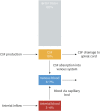Recent Updates on Controversies in Decompressive Craniectomy and Cranioplasty: Physiological Effect, Indication, Complication, and Management
- PMID: 37431371
- PMCID: PMC10329888
- DOI: 10.13004/kjnt.2023.19.e24
Recent Updates on Controversies in Decompressive Craniectomy and Cranioplasty: Physiological Effect, Indication, Complication, and Management
Abstract
Decompressive craniectomy (DCE) and cranioplasty (CP) are surgical procedures used to manage elevated intracranial pressure (ICP) in various clinical scenarios, including ischemic stroke, hemorrhagic stroke, and traumatic brain injury. The physiological changes following DCE, such as cerebral blood flow, perfusion, brain tissue oxygenation, and autoregulation, are essential for understanding the benefits and limitations of these procedures. A comprehensive literature search was conducted to systematically review the recent updates in DCE and CP, focusing on the fundamentals of DCE for ICP reduction, indications for DCE, optimal sizes and timing for DCE and CP, the syndrome of trephined, and the debate on suboccipital CP. The review highlights the need for further research on hemodynamic and metabolic indicators following DCE, particularly in relation to the pressure reactivity index. It provides recommendations for early CP within three months of controlling increased ICP to facilitate neurological recovery. Additionally, the review emphasizes the importance of considering suboccipital CP in patients with persistent headaches, cerebrospinal fluid leakage, or cerebellar sag after suboccipital craniectomy. A better understanding of the physiological effects, indications, complications, and management strategies for DCE and CP to control elevated ICP will help optimize patient outcomes and improve the overall effectiveness of these procedures.
Keywords: Craniocerebral trauma; Craniotomy; Decompressive craniectomy; Intracranial pressure.
Copyright © 2023 Korean Neurotraumatology Society.
Conflict of interest statement
Conflict of Interest: The authors have no financial conflicts of interest.
Figures







Similar articles
-
Recommendations for the management of cerebral and cerebellar infarction with swelling: a statement for healthcare professionals from the American Heart Association/American Stroke Association.Stroke. 2014 Apr;45(4):1222-38. doi: 10.1161/01.str.0000441965.15164.d6. Epub 2014 Jan 30. Stroke. 2014. PMID: 24481970
-
Cranioplasty Following Decompressive Craniectomy.Front Neurol. 2020 Jan 29;10:1357. doi: 10.3389/fneur.2019.01357. eCollection 2019. Front Neurol. 2020. PMID: 32063880 Free PMC article. Review.
-
Cranioplasty complications following wartime decompressive craniectomy.Neurosurg Focus. 2010 May;28(5):E3. doi: 10.3171/2010.2.FOCUS1026. Neurosurg Focus. 2010. PMID: 20568943
-
The effect of cranioplasty following decompressive craniectomy on cerebral blood perfusion, neurological, and cognitive outcome.J Neurosurg. 2018 Jan;128(1):229-235. doi: 10.3171/2016.10.JNS16678. Epub 2017 Mar 3. J Neurosurg. 2018. PMID: 28298042
-
Efficacy of decompressive craniectomy in the management of intracranial pressure in severe traumatic brain injury.J Neurosurg Sci. 2019 Aug;63(4):425-440. doi: 10.23736/S0390-5616.17.04133-9. Epub 2017 Nov 7. J Neurosurg Sci. 2019. PMID: 29115100 Review.
Cited by
-
Decompressive craniectomy in children: a lifesaving neurosurgical procedure in traumatic cases.Neurosurg Rev. 2024 Oct 4;47(1):729. doi: 10.1007/s10143-024-02982-0. Neurosurg Rev. 2024. Retraction in: Neurosurg Rev. 2025 Feb 6;48(1):203. doi: 10.1007/s10143-025-03356-w. PMID: 39365351 Retracted. No abstract available.
-
Astrocytoma Mimicking Herpetic Meningoencephalitis: The Role of Non-Invasive Multimodal Monitoring in Neurointensivism.Neurol Int. 2023 Nov 29;15(4):1403-1410. doi: 10.3390/neurolint15040090. Neurol Int. 2023. PMID: 38132969 Free PMC article.
-
Malignant Cerebral Edema After Cranioplasty: A Case Report and Literature Insights.Am J Case Rep. 2025 Jan 8;26:e946230. doi: 10.12659/AJCR.946230. Am J Case Rep. 2025. PMID: 39774935 Free PMC article. Review.
-
Letter to the Editor: Commentary on Predictor of the Postoperative Swelling After Craniotomy for Spontaneous Intracerebral Hemorrhage: Sphericity Index as a Novel Parameter (Korean J Neurotrauma 2023;19:333-347).Korean J Neurotrauma. 2024 Mar 8;20(1):75-76. doi: 10.13004/kjnt.2024.20.e6. eCollection 2024 Mar. Korean J Neurotrauma. 2024. PMID: 38576505 Free PMC article. No abstract available.
References
Publication types
LinkOut - more resources
Full Text Sources
Miscellaneous

